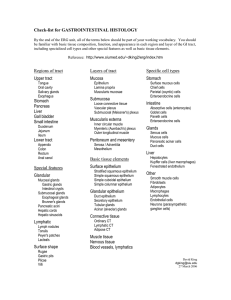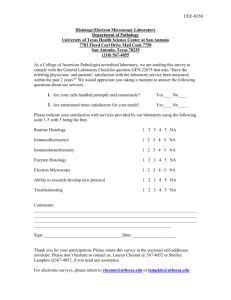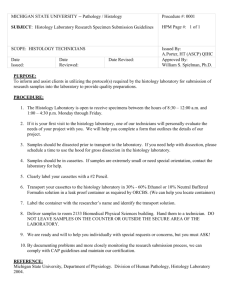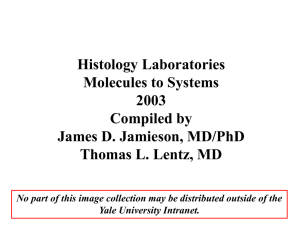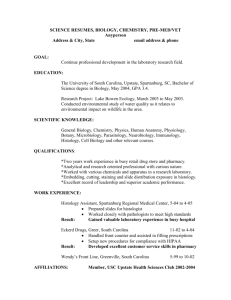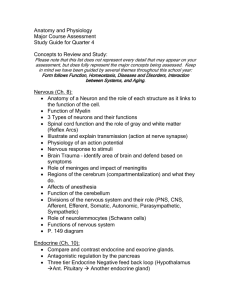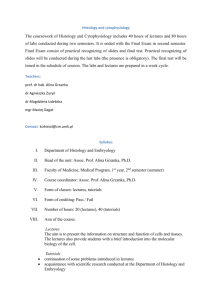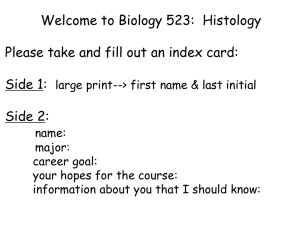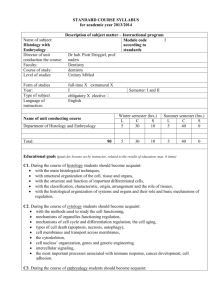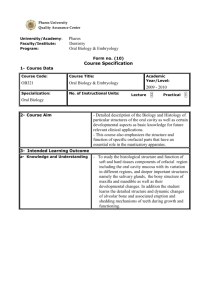Checklist
advertisement
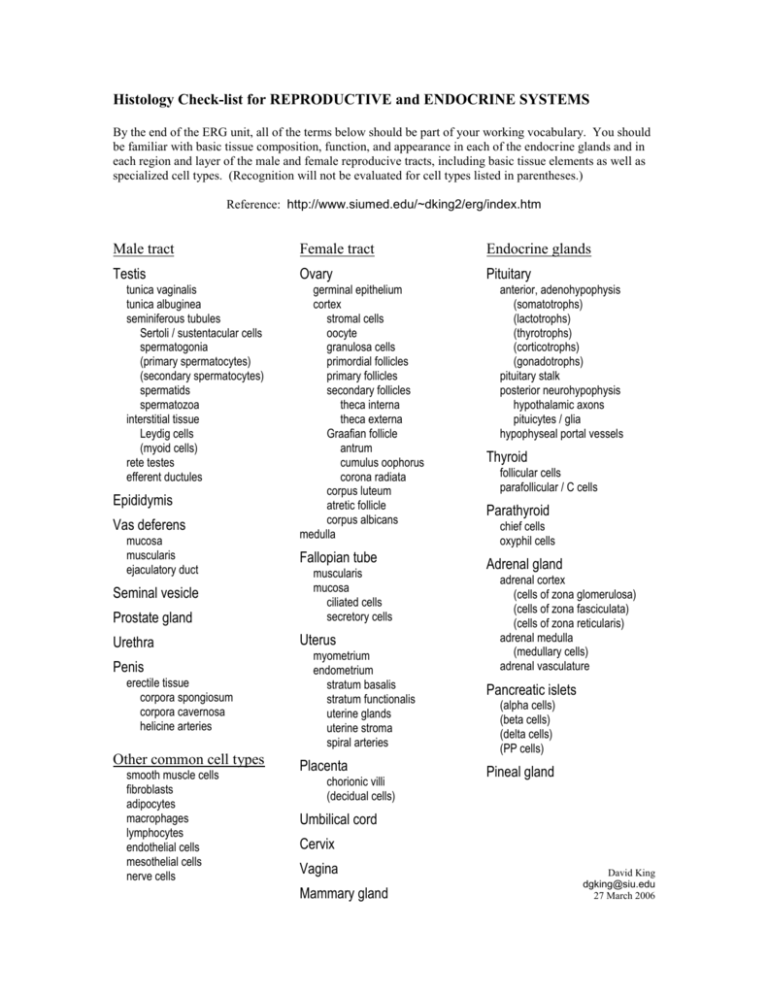
Histology Check-list for REPRODUCTIVE and ENDOCRINE SYSTEMS By the end of the ERG unit, all of the terms below should be part of your working vocabulary. You should be familiar with basic tissue composition, function, and appearance in each of the endocrine glands and in each region and layer of the male and female reproducive tracts, including basic tissue elements as well as specialized cell types. (Recognition will not be evaluated for cell types listed in parentheses.) Reference: http://www.siumed.edu/~dking2/erg/index.htm Male tract Female tract Endocrine glands Testis Ovary Pituitary tunica vaginalis tunica albuginea seminiferous tubules Sertoli / sustentacular cells spermatogonia (primary spermatocytes) (secondary spermatocytes) spermatids spermatozoa interstitial tissue Leydig cells (myoid cells) rete testes efferent ductules Epididymis Vas deferens mucosa muscularis ejaculatory duct Seminal vesicle Prostate gland Urethra Penis erectile tissue corpora spongiosum corpora cavernosa helicine arteries Other common cell types smooth muscle cells fibroblasts adipocytes macrophages lymphocytes endothelial cells mesothelial cells nerve cells germinal epithelium cortex stromal cells oocyte granulosa cells primordial follicles primary follicles secondary follicles theca interna theca externa Graafian follicle antrum cumulus oophorus corona radiata corpus luteum atretic follicle corpus albicans medulla Fallopian tube muscularis mucosa ciliated cells secretory cells Uterus myometrium endometrium stratum basalis stratum functionalis uterine glands uterine stroma spiral arteries Placenta chorionic villi (decidual cells) anterior, adenohypophysis (somatotrophs) (lactotrophs) (thyrotrophs) (corticotrophs) (gonadotrophs) pituitary stalk posterior neurohypophysis hypothalamic axons pituicytes / glia hypophyseal portal vessels Thyroid follicular cells parafollicular / C cells Parathyroid chief cells oxyphil cells Adrenal gland adrenal cortex (cells of zona glomerulosa) (cells of zona fasciculata) (cells of zona reticularis) adrenal medulla (medullary cells) adrenal vasculature Pancreatic islets (alpha cells) (beta cells) (delta cells) (PP cells) Pineal gland Umbilical cord Cervix Vagina Mammary gland David King dgking@siu.edu 27 March 2006 Learning Resources for ERG Histology Scheduled Activities: See ERG Unit Calendar (or www.siumed.edu/~dking2/erg/advice.htm#calendar). On-line study guide: www.siumed.edu/~dking2/erg/index.htm Other internet materials: U. of Utah, The Internet Pathology Laboratory: www-medlib.med.utah.edu/WebPath/webpath.html U. of Iowa, Virtual Slidebox: http://www.path.uiowa.edu/virtualslidebox/ More: http://www.siumed.edu/anatomy/histolinks.htm Self-assessment questions (at the on-line study guide, above). SAQ slides (unlabelled "unknown" slides, available in MRC). Textbooks. All students should read at least one introductory text. All of the following are roughly equivalent in depth and coverage, appropriate for the level of understanding expected in our current year-one curriculum. Your choice may be based on availability or on personal preference (style varies markedly among texts). Human Histology, 2nd ed. (1997), Stevens & Lowe. [Dr. King's personal favorite, concise and with illustrative pathology; weak on physiology.] Wheater's Functional Histology: A Text and Colour Atlas, 4th ed. (2000), Young & Heath (eds.). Histology: A Text and Atlas, 5th ed. (2006), Ross & Pawlina. Atlases. Just as with snapshots of landscapes or persons, single micrographs are seldom sufficient to catch the full character or personality of a tissue. Since any given text typically illustrates each organ/region with only one or two images, students are encouraged to view several sources for multiple images. Histology atlases (some are examples listed below) are quite useful for this purpose, but personal possession of an atlas should not be necessary. An Atlas of Histology (1976), Rhodin. Excellent source for electron microscope images. Although out of print, multiple copies are available in the MRC. Color Atlas of Basic Histology, 3rd ed. (2003), Berman & Milikowski. Color Atlas of Basic Histopathology (1997), Milikowski & Berman (an excellent resource for images of particular pathologies). References. The following are much more substantial (heavier, much more detail, 1200 vs. 400 pp.), better for reference than for introductory exposure. Students should be aware that such resources exist, but personal ownership is not recommended. Histology for Pathologists (1998), Sternberg. Robbins Pathologic Basis of Disease, 6th ed. (1999), Cotran, et al. Textbook of Histology, 12th ed. (2001), Fawcett.
